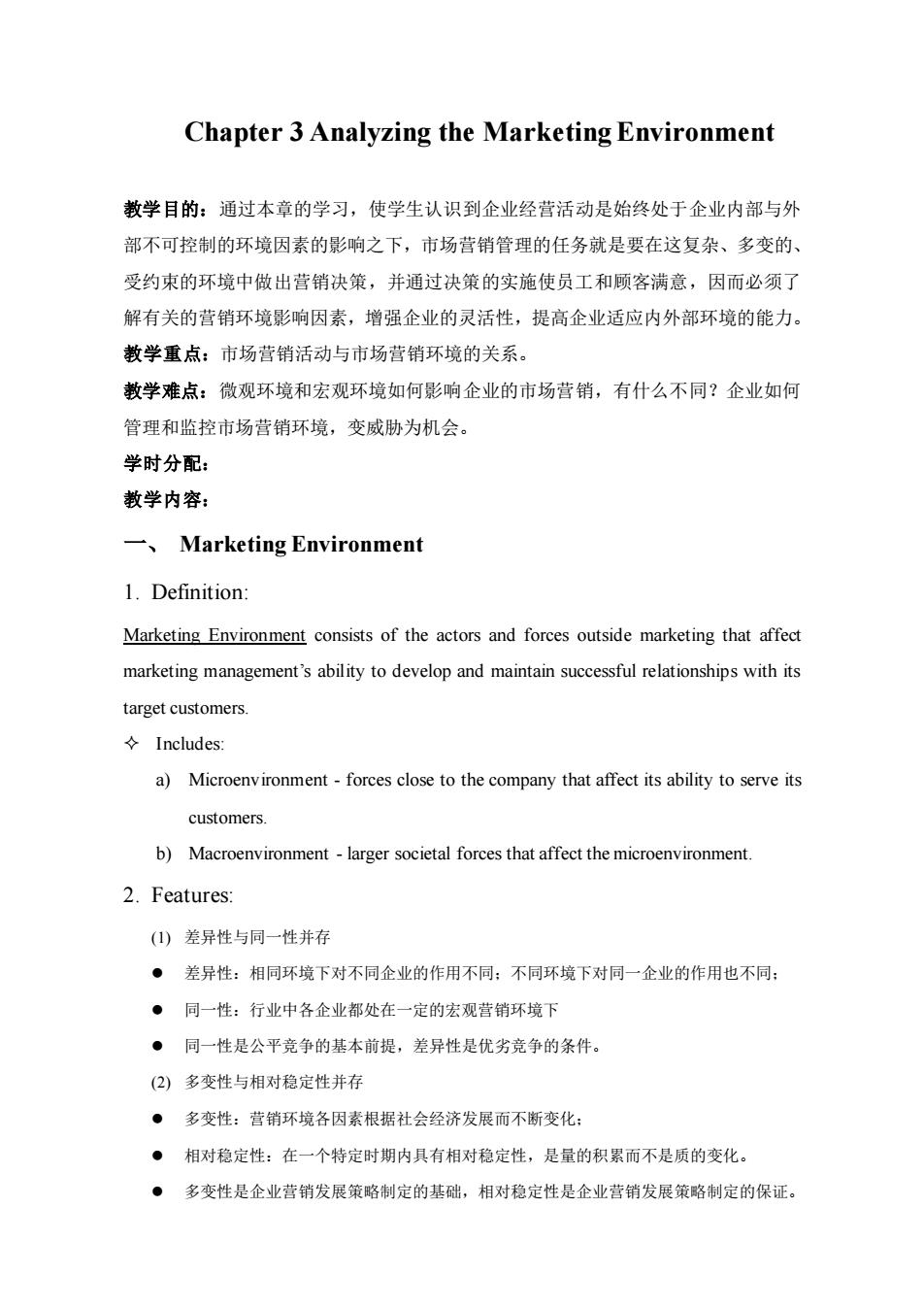
Chapter 3 Analyzing the Marketing Environment 教学目的:通过本章的学习,使学生认识到企业经营活动是始终处于企业内部与外 部不可控制的环境因素的影响之下,市场营销管理的任务就是要在这复杂、多变的、 受约束的环境中做出营销决策,并通过决策的实施使员工和顾客满意,因而必须了 解有关的营销环境影响因素,增强企业的灵活性,提高企业适应内外部环境的能力: 教学重点:市场营销活动与市场营销环境的关系。 教学难点:微观环境和宏观环境如何影响企业的市场营销,有什么不同?企业如何 管理和监控市场营销环境,变威胁为机会。 学时分配: 教学内容: 一、Marketing Environment 1.Definition: Marketing Environment consists of the actors and forces outside marketing that affect marketing management's ability to develop and maintain successful relationships with its target customers. 令Includes: a)Microenvironment-forces close to the company that affect its ability to serve its customers. b)Macroenvironment-larger societal forces that affect the microenvironment. 2.Features: (1)差异性与同一性并存 ·差异性:相同环境下对不同企业的作用不同:不同环境下对同一企业的作用也不同: ·同一性:行业中各企业都处在一定的宏观营销环境下 ·同一性是公平竞争的基本前提,差异性是优劣竞争的条件, (2)多变性与相对稳定性并存 ·多变性:营销环境各因素根据社会经济发展而不断变化: ·相对稳定性:在一个特定时期内具有相对稳定性,是量的积累而不是质的变化。 ·多变性是企业营销发展策略制定的基础,相对稳定性是企业营销发展策略制定的保证
Chapter 3 Analyzing the Marketing Environment 教学目的:通过本章的学习,使学生认识到企业经营活动是始终处于企业内部与外 部不可控制的环境因素的影响之下,市场营销管理的任务就是要在这复杂、多变的、 受约束的环境中做出营销决策,并通过决策的实施使员工和顾客满意,因而必须了 解有关的营销环境影响因素,增强企业的灵活性,提高企业适应内外部环境的能力。 教学重点:市场营销活动与市场营销环境的关系。 教学难点:微观环境和宏观环境如何影响企业的市场营销,有什么不同?企业如何 管理和监控市场营销环境,变威胁为机会。 学时分配: 教学内容: 一、 Marketing Environment 1. Definition: Marketing Environment consists of the actors and forces outside marketing that affect marketing management’s ability to develop and maintain successful relationships with its target customers. Includes: a) Microenvironment - forces close to the company that affect its ability to serve its customers. b) Macroenvironment - larger societal forces that affect the microenvironment. 2. Features: (1) 差异性与同一性并存 ⚫ 差异性:相同环境下对不同企业的作用不同;不同环境下对同一企业的作用也不同; ⚫ 同一性:行业中各企业都处在一定的宏观营销环境下 ⚫ 同一性是公平竞争的基本前提,差异性是优劣竞争的条件。 (2) 多变性与相对稳定性并存 ⚫ 多变性:营销环境各因素根据社会经济发展而不断变化; ⚫ 相对稳定性:在一个特定时期内具有相对稳定性,是量的积累而不是质的变化。 ⚫ 多变性是企业营销发展策略制定的基础,相对稳定性是企业营销发展策略制定的保证
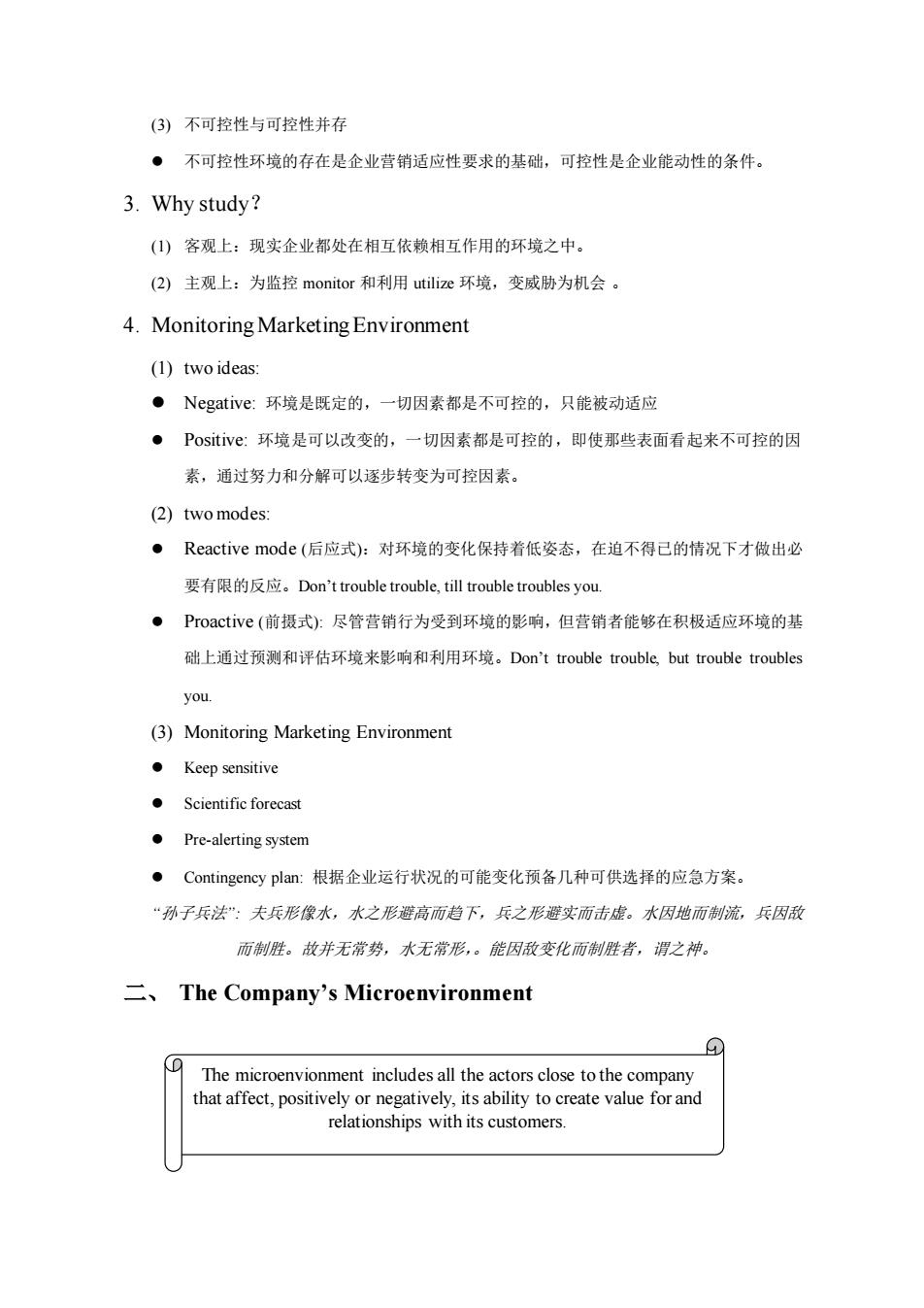
(3)不可控性与可控性并存 ·不可控性环境的存在是企业营销适应性要求的基础,可控性是企业能动性的条件】 3.Why study? ()客观上:现实企业都处在相互依赖相互作用的环境之中。 (2)主观上:为监控monitor和利用utilize环境,变威胁为机会 4.Monitoring Marketing Environment (1)two ideas: 。Negative:环境是既定的,一切因素都是不可控的,只能被动适应 ·Positive:环境是可以改变的,一切因素都是可控的,即使那些表面看起来不可控的因 素,通过努力和分解可以逐步转变为可控因素。 (2)twomodes: ·Reactive mode(后应式):对环境的变化保持者低姿态,在迫不得已的情况下才做出必 要有限的反应。Don'ttrouble trouble,till trouble troubles you. ·Proactive(前摄式):尽管营销行为受到环境的影响,但营销者能够在积极适应环境的基 础上通过预测和评估环境来影响和利用环境。Don'trouble trouble,but trouble troubles you. (3)Monitoring Marketing Environment ·Keep sensitive ·Scientific forecast ·Pre-alerting system ●Contingency plan:根据企业运行状况的可能变化预备几种可供选择的应急方案。 “孙子兵法”:夫兵形像水,水之形避高而趋下,兵之形避实而击虚。水因地而制流,兵因敌 而制胜。故并无常势,水无常形。能因敌变化而制胜者,谓之神 二、The Company's Microenvironment The microenvionment includes all theactortothe company that affect,positively or negatively,its ability to create value for and relationships with its customers
(3) 不可控性与可控性并存 ⚫ 不可控性环境的存在是企业营销适应性要求的基础,可控性是企业能动性的条件。 3. Why study? (1) 客观上:现实企业都处在相互依赖相互作用的环境之中。 (2) 主观上:为监控 monitor 和利用 utilize 环境,变威胁为机会 。 4. Monitoring Marketing Environment (1) two ideas: ⚫ Negative: 环境是既定的,一切因素都是不可控的,只能被动适应 ⚫ Positive: 环境是可以改变的,一切因素都是可控的,即使那些表面看起来不可控的因 素,通过努力和分解可以逐步转变为可控因素。 (2) two modes: ⚫ Reactive mode (后应式):对环境的变化保持着低姿态,在迫不得已的情况下才做出必 要有限的反应。Don’t trouble trouble, till trouble troubles you. ⚫ Proactive (前摄式): 尽管营销行为受到环境的影响,但营销者能够在积极适应环境的基 础上通过预测和评估环境来影响和利用环境。Don’t trouble trouble, but trouble troubles you. (3) Monitoring Marketing Environment ⚫ Keep sensitive ⚫ Scientific forecast ⚫ Pre-alerting system ⚫ Contingency plan: 根据企业运行状况的可能变化预备几种可供选择的应急方案。 “孙子兵法”: 夫兵形像水,水之形避高而趋下,兵之形避实而击虚。水因地而制流,兵因敌 而制胜。故并无常势,水无常形,。能因敌变化而制胜者,谓之神。 二、 The Company’s Microenvironment The microenvionment includes all the actors close to the company that affect, positively or negatively, its ability to create value for and relationships with its customers
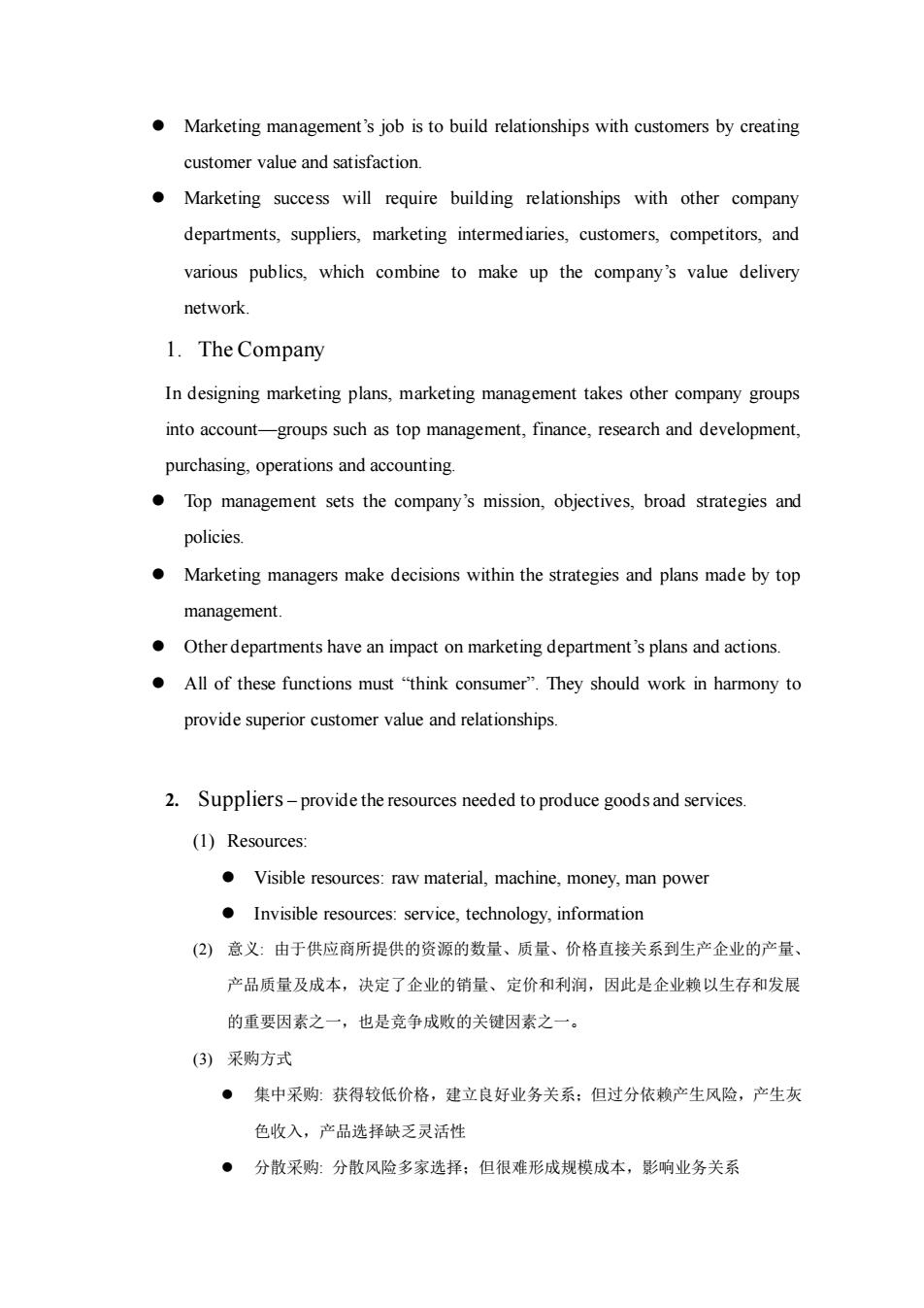
Marketing management's job is to build relationships with customers by creating customer value and satisfaction Marketing success will require building relationships with other company departments,suppliers,marketing intermediaries,customers,competitors,and various publics,which combine to make up the company's value delivery network. 1.The Company In designing marketing plans,marketing management takes other company group into account-groups such as top management,finance,research and development. purchasing,operations and accounting. Top management sets the company's mission,objectives,broad strategies and policies. Marketing managers make decisions within the strategies and plans made by top management. Otherdepartments have an impact on marketing department's plans and actions. All of these functions must"think consumer".They should work in harmony to provide superior customer value and relationships. 2.Suppliers-provide the resources needed to produce goods and services. (1)Resources: Visible resources:raw material,machine,money,man power Invisible resources:service,technology,information (2)意义:由于供应商所提供的资源的数量、质量、价格直接关系到生产企业的产量 产品质量及成本,决定了企业的销量、定价和利润,因此是企业赖以生存和发展 的重要因素之一,也是竞争成败的关键因素之一。 (3)采购方式 ·集中采购:获得较低价格,建立良好业务关系:但过分依赖产生风险,产生灰 色收入,产品选择缺乏灵活性 ·分散采购:分散风险多家选择:但很难形成规模成本,影响业务关系
⚫ Marketing management’s job is to build relationships with customers by creating customer value and satisfaction. ⚫ Marketing success will require building relationships with other company departments, suppliers, marketing intermediaries, customers, competitors, and various publics, which combine to make up the company’s value delivery network. 1. The Company In designing marketing plans, marketing management takes other company groups into account—groups such as top management, finance, research and development, purchasing, operations and accounting. ⚫ Top management sets the company’s mission, objectives, broad strategies and policies. ⚫ Marketing managers make decisions within the strategies and plans made by top management. ⚫ Other departments have an impact on marketing department’s plans and actions. ⚫ All of these functions must “think consumer”. They should work in harmony to provide superior customer value and relationships. 2. Suppliers – provide the resources needed to produce goods and services. (1) Resources: ⚫ Visible resources: raw material, machine, money, man power ⚫ Invisible resources: service, technology, information (2) 意义: 由于供应商所提供的资源的数量、质量、价格直接关系到生产企业的产量、 产品质量及成本,决定了企业的销量、定价和利润,因此是企业赖以生存和发展 的重要因素之一,也是竞争成败的关键因素之一。 (3) 采购方式 ⚫ 集中采购: 获得较低价格,建立良好业务关系;但过分依赖产生风险,产生灰 色收入,产品选择缺乏灵活性 ⚫ 分散采购: 分散风险多家选择;但很难形成规模成本,影响业务关系
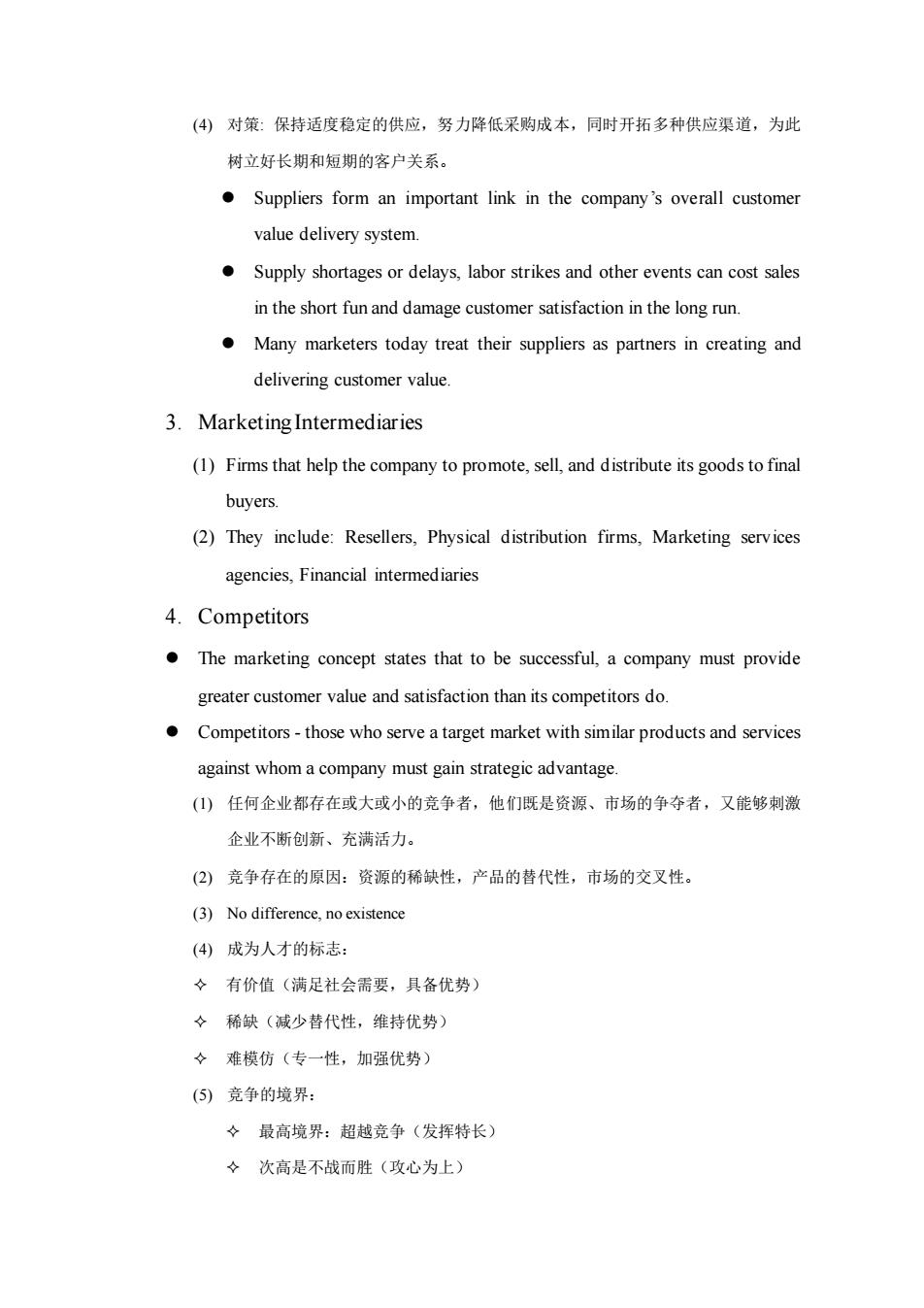
(4)对策:保持适度稳定的供应,努力降低采购成本,同时开拓多种供应渠道,为此 树立好长期和短期的客户关系。 Suppliers form an important link in the company's overall customer value delivery system. Supply shortages or delays,labor strikes and other events can cost sales in the short fun and damage customer satisfaction in the long run. Many marketers today treat their suppliers as partners in creating and delivering customer value 3.Marketing Intermediaries (1)Firms that help the company to promote,sell,and distribute its goods to final buyers. (2)They include:Resellers,Physical distribution firms,Marketing services agencies,Financial intermediaries 4.Competitors The marketing concept states that to be successful,a company must provide greater customer value and satisfaction than its competitors do. Competitors-those who serve a target market with similar products and services against whom a company must gain strategic advantage ()任何企业都存在或大或小的竞争者,他们既是资源、市场的争夺者,又能够刺激 企业不断创新、充满活力。 (2)竞争存在的原因:资源的稀缺性,产品的替代性,市场的交叉性。 (3)No difference,no existence (4)成为人才的标志: 令有价值(满足社会需要,具备优势) 令稀缺(减少替代性,维持优势) 令难模仿(专一性,加强优势 (⑤)竞争的境界: 夕最高境界:超越竞争(发挥特长) 令次高是不战而胜(攻心为上)
(4) 对策: 保持适度稳定的供应,努力降低采购成本,同时开拓多种供应渠道,为此 树立好长期和短期的客户关系。 ⚫ Suppliers form an important link in the company’s overall customer value delivery system. ⚫ Supply shortages or delays, labor strikes and other events can cost sales in the short fun and damage customer satisfaction in the long run. ⚫ Many marketers today treat their suppliers as partners in creating and delivering customer value. 3. Marketing Intermediaries (1) Firms that help the company to promote, sell, and distribute its goods to final buyers. (2) They include: Resellers, Physical distribution firms, Marketing services agencies, Financial intermediaries 4. Competitors ⚫ The marketing concept states that to be successful, a company must provide greater customer value and satisfaction than its competitors do. ⚫ Competitors - those who serve a target market with similar products and services against whom a company must gain strategic advantage. (1) 任何企业都存在或大或小的竞争者,他们既是资源、市场的争夺者,又能够刺激 企业不断创新、充满活力。 (2) 竞争存在的原因:资源的稀缺性,产品的替代性,市场的交叉性。 (3) No difference, no existence (4) 成为人才的标志: 有价值(满足社会需要,具备优势) 稀缺(减少替代性,维持优势) 难模仿(专一性,加强优势) (5) 竞争的境界: 最高境界:超越竞争(发挥特长) 次高是不战而胜(攻心为上)
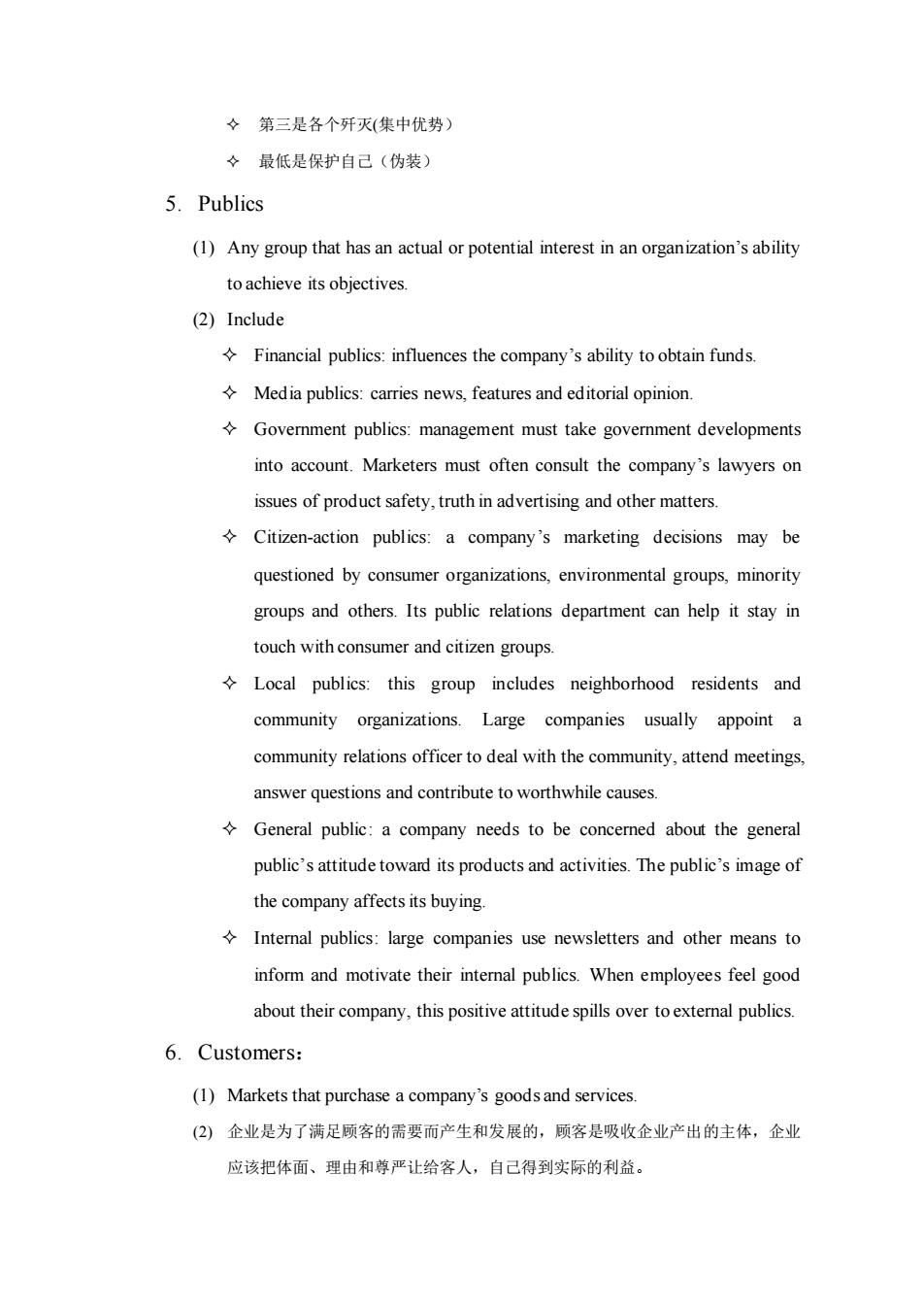
令第三是各个歼灭(集中优势) 令最低是保护自己(伪装) 5.Publics (1)Any group that has an actual or potential interest in an organization's ability to achieve its objectives (2)Include Financial publics:influences the company's ability to obtain funds. Media publics:carries news,features and editorial opinion Government publics:management must take government developments into account.Marketers must often consult the company's lawyers on issues of product safety,truth in advertising and other matters. Citizen-action publics:a company's marketing decisions may be questioned by consumer organizations,environmental groups,minority groups and others.Its public relations department can help it stay in touch with consumer and citizen groups. Local publics:this group includes neighborhood residents and community organizations.Large companies usually appoint a community relations officer to deal with the community,attend meetings, answer questions and contribute to worthwhile causes. General public:a company needs to be concemed about the general public's attitude toward its products and activities.The public's image of the company affects its buying. Intemal publics:large companies use newsletters and other means to inform and motivate their internal publics.When employees feel good about their company,this positive attitude spills over toexternal publics. 6.Customers: (1)Markets that purchase a company's goodsand services. (2)企业是为了满足顾客的需要而产生和发展的,顾客是吸收企业产出的主体,企业 应该把体面、理由和尊严让给客人,自己得到实际的利益
第三是各个歼灭(集中优势) 最低是保护自己(伪装) 5. Publics (1) Any group that has an actual or potential interest in an organization’s ability to achieve its objectives. (2) Include Financial publics: influences the company’s ability to obtain funds. Media publics: carries news, features and editorial opinion. Government publics: management must take government developments into account. Marketers must often consult the company’s lawyers on issues of product safety, truth in advertising and other matters. Citizen-action publics: a company’s marketing decisions may be questioned by consumer organizations, environmental groups, minority groups and others. Its public relations department can help it stay in touch with consumer and citizen groups. Local publics: this group includes neighborhood residents and community organizations. Large companies usually appoint a community relations officer to deal with the community, attend meetings, answer questions and contribute to worthwhile causes. General public: a company needs to be concerned about the general public’s attitude toward its products and activities. The public’s image of the company affects its buying. Internal publics: large companies use newsletters and other means to inform and motivate their internal publics. When employees feel good about their company, this positive attitude spills over to external publics. 6. Customers: (1) Markets that purchase a company’s goods and services. (2) 企业是为了满足顾客的需要而产生和发展的,顾客是吸收企业产出的主体,企业 应该把体面、理由和尊严让给客人,自己得到实际的利益